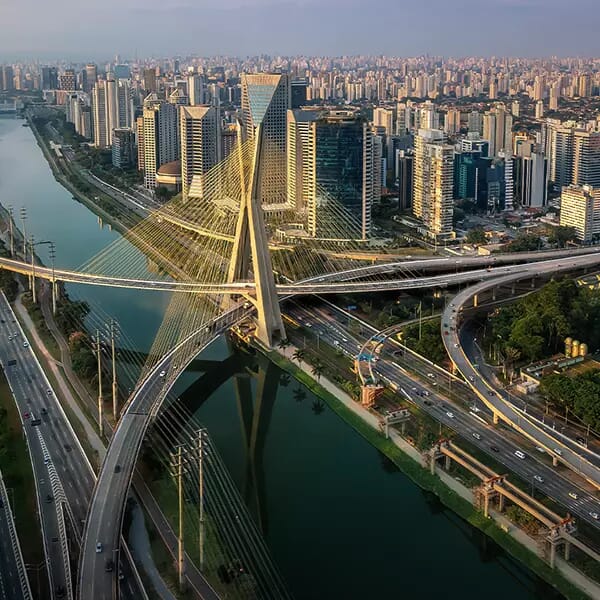 Credit: Twenty20Photos
Credit: Twenty20PhotosP3s in the Pacific Alliance
On 3 March 2021, the GRI Club held an eMeeting titled "P3s in the Pacific Alliance", in which was discussed the role of P3s in the Pacific Alliance and infrastructure investment challenges and opportunities.
Our moderators were Yuriria Mascott, legal consultant, at Baker McKenzie LLP, and Antonio Ortuzar and Carolina Duque, Partners at Baker McKenzie, and our Special Guest were Juan Miguel Custodio of Macquarie, Roberto Martinez of the OECD, and Cesar Ramirez of Union para la Infraestructura (UPI).
 Credit: nblxer / Envato Elements
Credit: nblxer / Envato Elements
The discussion led to this white paper, which explores current investment opportunities in P3s in the Pacific Alliance.
1. Economic reactivation
While recovery will be slow, which will be a barrier, the role of infrastructure will be a strategic driver of economic reactivation. In fact, it will be key. The pandemic had a big impact on both our society and our economy. The results of this global catastrophe have even been compared to the effects of a world war. With that being said, it will be a slow process. Governments in the Pacific Alliance are currently facing a difficult situation, a reduction in private capital. However, there is investor uncertainty, which prevents private capital from flowing to infrastructure projects. We will need governance and transparency for economic reactivation.
The panelists discussed how different countries in the region were responding to the reactivation of the economy. Peru is currently undergoing a change in government, and reactivation has stalled. Auctions on certain infrastructure projects for private investment are currently on hold, and there is no political strength to carry out the bid process on these projects. In fact, there has been political uncertainty for the last three or four years in Peru. It is unclear what the future holds, and the election results in April will determine what will occur in the revival of the economy.
On the other hand, with the new presidency in Colombia, the Colombian government has made a commitment to respond to the need for economic recovery. Colombia has implemented initiatives, and the government continues to invest in 5G electric vehicles and promote infrastructure. There is a push from the administration to boost the infrastructure sector as a whole. In Mexico, however, Andres López Obrador has sent mixed messages. During the pandemic, there has been minimum financial support from the administration. While there is concentration in large projects, such as the Maya Train, there is great uncertainty in the energy sector. The pace of economic reactivation will vary depending on the country. If we are looking to accelerate reactivation, we must look at how the governments are reacting, and their efforts to promote public-private partnerships.
Colombia and Chile have both put forth emphasis on economic recuperation, and there is in fact an appetite for developing infrastructure in these countries. Aside from the infrastructure sector, the digital sector has also become notable for investors, and those that are not involved in this market are already behind the times. Digital infrastructure will improve connectivity within a country, and more importantly, throughout the region. While there may be less activity in Latin America compared to the United States, we are still seeing strong digital infrastructure efforts in Chile and Colombia. There is also noticeable appetite in the health sector, and services that address social well-being, such as hospitals and laboratories. These investments will have a direct impact on the resurgence of the economy. Not only are they expected to play a major role in reactivating the economy, more importantly, they are considered fundamental to our society.
 Credit: David Lienemann / Biden For President / Flickr
Credit: David Lienemann / Biden For President / Flickr
2. The Biden administration’s focus on renewable energies and climate change and its potential benefits/challenges in Latin America’s current trade relationship with China
Before the pandemic, there was a peculiar phenomenon in global value chains; a relative decrease in global manufacturing. There was also an increase in trade restrictions, considering the precarious China-US relations. In this context, the reaction of the market was to approach with caution. Global trade groups discussed the situation – specifically, how to persuade and attract investment to the region. The plan is to create confidence and certainty among decision makers and leaders of major manufacturers. As a result, corporations in the supply chain could continue their operations in this region, instead of APAC. There is a window of opportunity for the Pacific Alliance to take advantage of this displacement from Asia to our region. The new Biden administration may provide more such opportunities and at the same time, improve the relationship between China and the United States. If Pacific Alliance countries want to strengthen their foothold, it will depend on how well they can adopt and carry out best practices. There is a need for homologation of international best practices and standards.
On the other hand, there is also the need to invest in clean projects. Investors should focus on developing renewable energy projects since this is the future. We see how these projects affect climate change, and the market will have to adapt to the increase in green projects. The new Biden administration has demonstrated its commitment, for example, by rejoining the Paris agreement. In the past, renewable energy was considered too expensive, but that is no longer the case. Clean energy is just as competitive, and even less so in some cases than fossil fuel generation. Managing change reflects the long-standing trend in global affairs. In a recent study by Preqin, where institutional investors were asked where they would increase investment, 90% said they would invest in renewables and digital infrastructure. We will start to see significance placed on these types of projects, from both governments as well as the private sector.
3. Private participation in infrastructure
Infrastructure not only promotes economic growth, but also undoubtedly raises the quality of life. The speakers were asked to discuss the current outlook of the infrastructure sector, from the perspective of the private sector and foreign investors.
During the pandemic, the market went through a transformation. Specifically, in the first three or four months, projects were paralyzed, and foreign funds were withdrawing from the Pacific Alliance region. In July, the appetite for investment began to return. One of the examples of this are: Trina Solar, a large Chinese solar panel company, which invested in various projects in four different countries in Latin America; Macquarie Capital's acquisition of a toll road in Colombia; Greenergy’s investment in Chile; and four highways were acquired in Mexico.
Many investors have P3s in the pipeline. When analyzing this market, investors are left with few options, and truly, the main market left is Latin America. In addition, the manner of investing is changing. Before, many investment funds were only reviewing returns; now, there are many other factors that play a role. Many investors are no longer looking at the return on investment; instead, they want to know if these infrastructure projects will contribute to improve the community. Investors are beginning to ask how projects will affect the indigenous population. They are analyzing environment and social responsibility (ESR) in these investments, and their overall social impact. Projects that improve quality of life are becoming just as important and fundamental as profitability.
Concerning Mexico, there is a lot of uncertainty due to the cancellation in auctions, and a loss of interest in working with the government. Due to this, working with the private sector seems a more attractive option. What is lacking is the governments’ promotion of the P3s in the Pacific Alliance, as this component is crucial for increasing investments in this arena. This is also a good opportunity to discuss the different ways to finance these projects.
 Credit: Leungchopan / Envato Elements
Credit: Leungchopan / Envato Elements
4. The role that international organizations and governments play in promoting private investment
The OECD supports many projects in infrastructure to guide investors and strengthen the team involved in these projects. The OECD has a history of accompanying investors to ensure they meet international standards on matters such as procurement, contracting, certification and training. As an example of collaboration in the Pacific Alliance, the OECD issued a report on standards in Chile, and addressed certain faults in this area. In order to encourage private investments, the OECD is dedicated to employing good governance, transparency and standards that generate confidence in the private sector. Collaboration between the public and private sector is fundamental.
The gap keeps growing between what the market needs and the projects that exist to meet those needs. Governments cannot assume this role unilaterally, because there are not enough resources to close this gap. For this reason, private investment in infrastructure is necessary, not only for the government, but to improve competitiveness. Additionally, in terms of technical capacity, a weight would be lifted, because the private sector has the experience and knowledge necessary to carry out highly technical projects. It is important and necessary for governments to work together with private investors to address lack of resources, technical capabilities and social problems that invariably occur. If the private sector and investors do not have the proper mechanisms to navigate and mitigate risks in these projects, then the only route available is the government. The role of the government in stimulating private participation should be to cooperate with private investors, particularly on social issues, and other obstacles that need to be navigated in these infrastructure projects.
Governments should assist the private sector in navigating risks, so that they may understand, mitigate and find solutions to these challenges. In new projects, it is crucial that the governments work in partnership with the private sector. The governments must listen to the market, and it should be noted that this is an area that leaves a lot of room for improvement. It is critical for governments to engage in a dialogue with the private sector, so that they can jointly reach solutions to common challenges. It is fundamental that the projects are well structured in order to facilitate development, and there is a clear need for robust, transparent international standards. The government must collaborate with investors, and work with them on how to address risks and challenges. It is key to create a level playing field for competition as well. This can only be achieved through discourse.

Everyone in the sector, public and private, are key players. We all play an important role in promoting these projects. Transparent governance is indispensable for investments in large projects, through this alone, we provide political certainty to investors.
Baker McKenzie
Baker McKenzie is recognized worldwide for its best-in-class client service, practices and for carrying out the most deals year-after-year through our unmatched global platform across 77 offices and 47 emerging and developed countries. Companies based in or with operations in Latin America, routinely rely on our leading cross-border and Latin America energy, mining & infrastructure attorneys for their most important transactional and disputes matters. As the largest law firm in Latin America with over 850 attorneys, we offer clients 60+ years of on-the-ground presence in the region, unique coverage in Latin America across our 15 offices and 7 countries*, and from major finance centers globally.
*Through a cooperation agreement with Trench Rossi Watanabe, a Brazilian law firm.
Our offices
Chile - Santiago
Avenida Andrés Bello 2457
Piso 19 Providencia, CL 7510689
Santiago
Colombia - Bogota
Avenue 82 No. - 10-62 6th Floor
Bogota
México - Ciudad de México
Lomas Virreyes / Col. Molino del Rey, Del. Miguel Hidalgo
Edificio Virreyes - Pedregal 24, piso 12
Ciudad de México
Peru - Lima
Av. Los Conquistadores 1118, Piso 6
San Isidro, 15073
Lima
Contact




